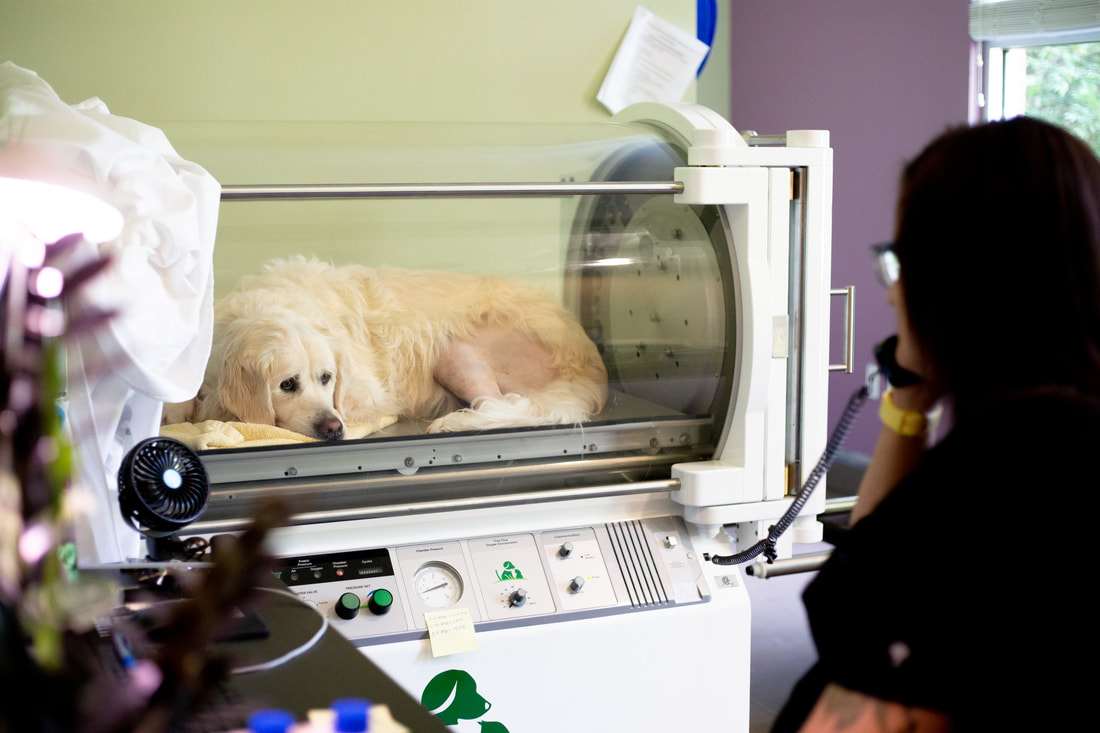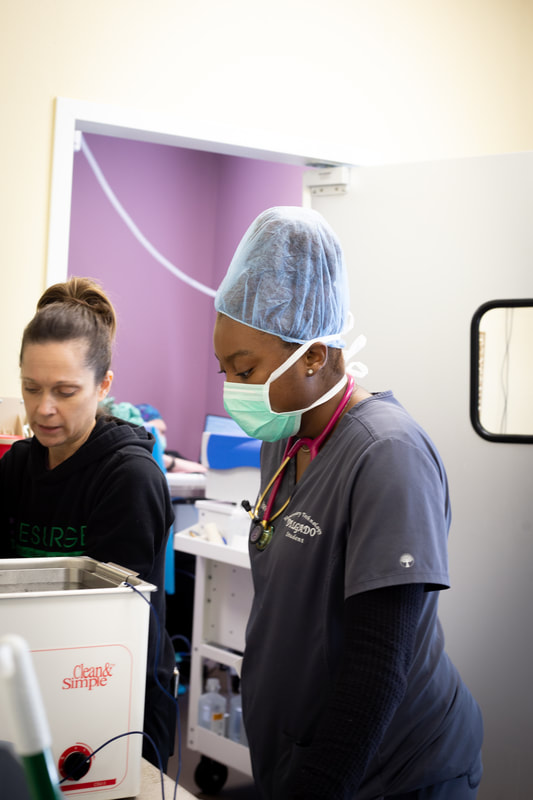 Clients routinely come in to have their pet’s skin staples removed and ask, “are you going to sedate them to take those out?”. Our answer 99% of the time is, “no”. Staples may look scary to the untrained eye but using them holds many benefits and there is a special tool that takes them out without any discomfort to the patient. As a matter of fact, the FDA states that skin staples can benefit patients in the following ways; • Quick placement. • Minimal tissue reaction. • Low risk of infection. • Strong incision/ wound closure. This means that our animal patients that get staples while having surgery have less time under anesthesia, less risk of having incisional complications, and they get the same great care, if not better, than their human care givers. This also means that there may be reduced costs due to less complications following a surgical procedure. If you are having anxiety over having your pet’s staples removed, check out our YouTube playlist below to see some animal patients having staples removed. We hope these videos will help lessen your stress and understand why and how skin staples are beneficial.
Many pet parents stress over their dog being afraid of water and how their dog will react in the underwater treadmill. It’s true that the underwater treadmill exercise can be scary, but we do everything we can to reduce that stress so that our patients can benefit from therapeutic exercise and recover to the best of their abilities. Our therapists have been training veterinary patients how to walk in underwater treadmills for more than 20 years. They generally have about an 97% success rate in getting dogs to walk on the treadmill within a minute and with minimal stress to the patient.
Check out our new and forever growing Youtube Shorts Playlist filled with our patients first steps in the underwater treadmill. Leo was born with an abnormal opening in his skull. Dr Roy “Boogie” Yates saw him when he was just a little kitten and at that time, part of Leo’s brain was essentially leaking out of the abnormal opening in his skull. Despite Leo’s brain being very vulnerable to trauma, he did well and continued to grow and do all the normal kitten things. As he developed, Dr Boogie would continue to recheck him and more recently Leo had a CT scan to better understand the details of his problem. The scan revealed that Leo’s brain had stopped growing through the abnormal opening, but Leo continued to have a large bulbous mass that is filled with fluid on the top of his head. This was good news, however, there is still concerns with Leo being more vulnerable to trauma. If Leo's head were to be accidentally punctured by a cat friend or sustained a blow to his head, it could have grave consequences. One of our Physical Rehabilitation Practitioners, Robert J Porter CCRP, was able to fit Leo with a custom helmet to better protect Leo as he continues to be a very playful kitten that lives life to its fullest. The biggest challenge in having a cat wear a helmet is having the cat wear a helmet. Most cats do not adapt well to wearing anything. If they do tolerate having something attached to their body it is generally short lived. Fortunately, Leo has been cared for by the Tomato Foster Club. His care givers were diligent in training him to wear the helmet and were very successful. Without the Tomato Foster Club’s help, Leo would not have gotten the care and training that made this endeavor successful. We will see Leo back periodically and make adjustments to his head gear as needed, but so far, Leo has learned to love his helmet and gets very excited about wearing it. Maybe it’s the food rewards, or maybe he just likes looking like a tomato. Leo is not up for adoption, but the Tomato Foster Club has plenty of other super awesome kitties that need homes. Please visit their website and/or follow them on social media. They have some especially funny merch and all proceeds go to helping their Clowder of Cats and Kindle of Kittens. #catsinhelmets #resurgevet #vetneurology #catscan Please visit our webpage or follow us: Insta: @resurgevet Facebook:https://www.facebook.com/resurgevet Donate. Adopt. Follow. https://tomatoclub.org Insta: @tomatofosterclub https://www.facebook.com/tomatofosterclub  Meet Aries, he’s a 13 week old puppy that is recovering from a surgery called juvenile pubic symphsiodesis or JPS for short. This procedure can ONLY be done between 10-18 weeks of age which leaves us a small window of opportunity to lessen lifelong suffering and make a huge difference in a dog’s quality of life. The JPS procedure can also save their human compounding veterinary medical bills throughout their new puppy’s life. Aries’ owner brought him to his veterinarian because he didn’t seem like a normal, active puppy. Instead Aries' activity periods seemed short and he would readily lay down after playing. Aries was displaying this behavior because his hips would become sore due to instability. Aries was referred to Dr Dena Lodato to be evaluated for hip dysplasia and she took him to surgery to perform a JPS. There are several surgical procedures that can help hip dysplasia but the earlier you can catch it, the less invasive, costly and more effective a procedure can be. The American College of Veterinary Surgeons website page on hip dysplasia states that a recent study reviewed published scientific studies concluded that JPS surgery is a method of consistently providing normal pain free hip function. JPS is a minimally invasive surgery that closes a growth plate at the bottom of the pelvis. This results in selective growth of the pelvis and the hip cup (acetabulum) increasingly covering the ball (femoral head) as the puppy grows during the following 4–6 months. Patients may be able to go home the same day after this procedure. If your puppy is “too good”, displaying a “default sit” or lays down more often than the normal dog, especially after playing, this may be a symptom of a hip dysplasia. Aries rechecked with the physical rehabilitation service today and no abnormalities were found. He, in fact, looked like a perfectly normal dog. It's TPLO Tuesday! Layla is exercising in our Underwater Treadmill and receiving LASER therapy while in recovery from a TPLO surgery. Even though this is the most common surgery we do at Resurge, each one of our patients has unique recovery needs that we cater to. Our goal is to meet the needs of our individual patients and give them every opportunity to fully recovery from their injury.
If you want to learn more about how recovery from a TPLO can be successful, please visit our blog on 10 tips and tricks to make TPLO surgery successful:It's TPLO Tuesday! Layla is exercising in our Underwater Treadmill and receiving LASER therapy while in recovery from a TPLO surgery. Even though this is the most common surgery we do at Resurge, each one of our patients has unique recovery needs that we cater to. Our goal is to meet the needs of our individual patients and give them every opportunity to fully recovery from their injury. If you want to learn more about how recovery from a TPLO can be successful, please visit our blog page: https://www.resurge.vet/.../10-tips-and-tricks-to-make... #TPLOTuesday #veterinarysurgery #CrCL #ACL #cruciatedisease #caninerehabilitation #TPLO #surgery https://www.resurge.vet/.../10-tips-and-tricks-to-make... #TPLOTuesday #veterinarysurgery #CrCL #ACL #cruciatedisease #caninerehabilitation #TPLO #surgery Joni presented with no sensation to her right rear leg and it was delayed in her left. This set of symptoms generally yields a poor prognosis. Dr. Dena Lodato brought her to surgery and decompressed the paralyzing disc herniation but she’s still has a long way to go before being able to function on her own. We still dont know how much function she will be able to recover but we are very hopeful. Joni just finished her first two weeks of physical rehabilitation and she is coming back next week to continue therapy. In the mean time, please keep her in your thoughts and prayers, she needs them. #neurorecovery #spinalcordinjury #nodeeppain Cat Barzon CHT-V, our hyperbaric technician, is singing Willa Happy Birthday while she receives a hyperbaric oxygen treatment. Willa had a tibial plateau leaving osteotomy, or TPLO, to stabilize her knee from a ACL/CrCL rupture. She’s been recovering well from surgery and has been receiving hyperbaric oxygen treatments to help with swelling and inflammation. You’ll be running around in no time Willa and your mom says there’s cake for when you get home:) #HBOT #happybirthday #TPLO #vetsurgery #resurge
Buddy suffered multiple strokes to his brain at the beginning of the year. He stayed with us for about a month while he recovered the ability walk and function on his own. Yesterday, his rehab therapists got to hang out with him and awe in how well he has been doing. Never give up on the older dog. They have wisdom, perseverance, and a lot of love to still give. Thanks for always being everyone’s buddy, Buddy! You can watch Buddy’s full video on the below. Slow motion gait analysis can help objectively evaluate and record a patient’s gait. After data is collected a practitioner can calculate acceleration, velocity, joint angles and watch a patient’s gait in repetition to gain more knowledge of how they are doing or what may be abnormal. Further studies can compare data before and after treatments to quantify progress. Our Rehabilitation department works closely with surgery patients and staff to make better decisions about what treatments are best for our patients.
|
|
Home
Services
About
Contact
Blog
Client Registration Form
Veterinary Referral information
|
|
Contact Us
|







